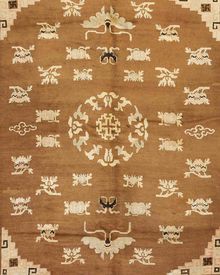Difference between revisions of "Mongolian Carpet"
| (2 intermediate revisions by 2 users not shown) | |||
| Line 1: | Line 1: | ||
{{Infobox Rug and Carpet | {{Infobox Rug and Carpet | ||
|above = | |above = | ||
| − | |image = | + | |image = [[File:Mongolian Carpet-WikiRug.jpg|frameless|220px]] |
|caption = | |caption = | ||
| Line 43: | Line 43: | ||
* Peter F. Stone. 2013. ''Oriental Rugs: An Illustrated Lexicon of Motifs, Materials, and Origins''. North Clarendon: Tuttle. | * Peter F. Stone. 2013. ''Oriental Rugs: An Illustrated Lexicon of Motifs, Materials, and Origins''. North Clarendon: Tuttle. | ||
| − | [[Category: | + | {{Template:Worlds Carpets}} |
| + | [[Category:Worlds Carpets]] | ||
[[fa:فرش مغولستان]] | [[fa:فرش مغولستان]] | ||
Latest revision as of 12:15, 14 September 2020
| Mongolian Carpet | |
|---|---|
 | |
| General information | |
| Name | Mongolian Carpet |
| Original name | فرش مغولستان، قالی مغولستان |
| Alternative name(s) | Mongolian Rug |
| Origin | |
| Technical information | |
| Common designs | Geometric, Vagireh |
| Common colors | Red, Pink |
| Foundation material | Cotton |
| Knot type | Asymmetrical (Persian) |
Mongolian Carpet or Mongolian Rug is one of the eastern rugs that woven in Mongolia.
Traditional rugs of Mongolia are quilted felt rugs (shirdeg or toiruulga). There are similar felt tent flaps and mats (olbog). The attribution of old pile rugs (xives) to Mongolia is highly speculative. The earliest rugs so attributed are from the nineteenth century. These rugs show Chinese design influences. The field consists of small geometrical motifs in a dense all-over pattern. Designs may include spandrels. Red and pink are the dominant colors. Rugs are small. The asymmetric knot is used and the foundation is cotton. Double wefts are used and there is no warp offset. In 1925, a pile rug factory was opened in Ulan Bator, the capital. There is contemporary production of low-quality pile rugs in Chinese designs with very bright colors on a cotton foundation.[1]
References
- ↑ Stone, 2013, 194
Bibliography
- Peter F. Stone. 2013. Oriental Rugs: An Illustrated Lexicon of Motifs, Materials, and Origins. North Clarendon: Tuttle.